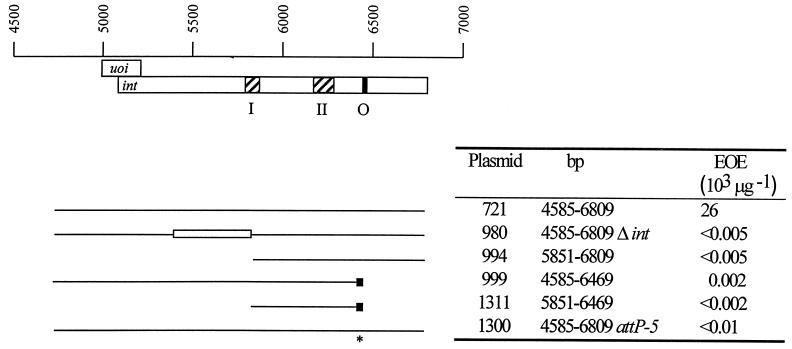FIG. 1.
Plasmids with the intX and attP5 mutations cannot integrate efficiently. Coordinates of Mx8 DNA inserts (base pairs), based on GenBank accession no. U64984 (29), are shown above the open boxes representing the uoi and int coding sequences (top) which, like the coliphage λ xis and int genes (10), overlap. The hatched regions in the int gene correspond to conserved domains I and II of integrases (2, 17); conserved domain II includes the active-site tyrosine residue (26). The filled region within int, O, is the attP common core. The extents of Mx8 DNA inserts present in each plasmid are shown as horizontal thin lines (bottom left). Mutant plasmids are derived from pAY721, which contains a 2.2-kb region of the Mx8 genome with the functional int-attP genes. pAY980 is a derivative of pAY721 with a deletion, Δint-5403/5851 (open box), that removes bp 5403 to 5851 internal to int, including a portion of a portion of domain I (19). pAY999 contains the attR site and encodes the recombinant IntX integrase, with an altered C terminus (small black box). pAY994 and pAY1131 contain smaller regions of int and intX with minimal, functional attP and attR sites, respectively. pAY1300 is an otherwise isogenic version of pAY721 in which the attP site has been inactivated by the attP5 mutation (asterisk) (see Fig. 2). These plasmids were used in experiments to measure the relative abilities of Int and IntX to mediate a subset of site-specific recombination reactions involving different combinations of att sites (see Fig. 3). The efficiencies of electroporation (EOE) of the plasmids are the numbers of Kmr recombinants arising per microgram of DNA electroporated into host DZ1 and are the averages of at least three independent determinations (see Materials and Methods). attP-5 is attP5.

